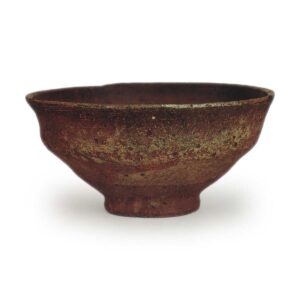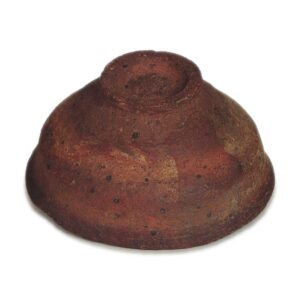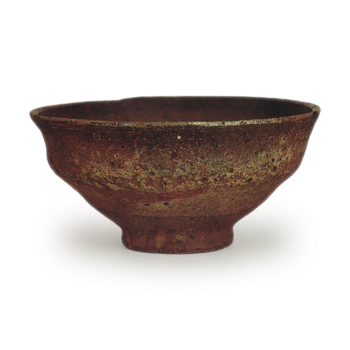

Important Cultural Property
Held by: Hatakeyama Memorial Museum
Height: 6.6 – 7.0 cm
Diameter: 1.35 – 14.1 cm
Outer diameter of foot: 5.5 – 5.6 cm
Height: 0.8 cm
This tea bowl, which is called the Bishamon-do tea bowl because it was originally in the Bishamon-do temple in Yamashina, Kyoto, is particularly well-shaped among the Kakiebi tea bowls, and is known as a famous tea bowl with a deep significance in its withered skin. The Bishamon-do in Yamashina is home to some of the most famous tea bowls in the world, including Koetsu’s Sekiraku tea bowl and the Kinsei-style Kintsuji Hōō-ji flower vase, and it is said that the reason why such famous tea bowls have gathered here is because the great priest Tenkai lived here in the early Edo period and wielded great influence.
There are many famous bowls in the Kakinoobi collection, including Kyogoku, Otsu, Tatsuta, Hakua, and Wani, but what particularly draws me to Bishamon-do is its appearance. The mouth is tight, the waist has a certain rhythm, and the foot ring is full of character. The unglazed, rough surface has a wabi-sabi quality reminiscent of a dry, old monk, and the iron particles contained in the clay have melted to add to the scenery. Some people have commented that there is nothing better than this tea bowl for quietly drinking tea than a well or a leaky roof, but when you pick it up, you can feel the reality of this humble tea bowl.
The clay is a sandy soil with a slight iron content, and a thin layer of transparent powder has been applied to it. The iron particles and quartz sand particles are both visible, with the iron areas burnt black and the quartz sand areas shining. As the firing was not done properly, the glaze has melted only halfway on one side, while the other side is raw and rough. However, the rough surface is not uniform, and there are subtle variations in color, with some areas tinged red and others yellow, which are the highlights of this teacup.
There is also a large unglazed area called a “himma” that runs from the body to the waist, and when this is wet it turns a reddish brown, adding to the charm of this teacup. There are four marks on the inside of the cup, but because the firing was not done properly, only these parts have turned a yellowish-brown, making this a teacup with a deep and varied charm on both the inside and outside. There is a small tear on the rim, which has been repaired with black lacquer.
The inner box is paulownia wood with a calligraphy inscription by Roka Hirase, which reads “Kakinoobi Chakonsho” on the front and “Yamashina Gomonato Gikyuzo no Hinomono” on the back, and the outer box is paulownia wood with a calligraphy inscription by Rogen Toda, which reads “Kakinobai Takarajawan” on the front and “Kakinoobi Chakonsho Goshozono Gokozou” on the back. Kirei tea bowl” and on the back, ”This tea bowl was in the possession of the Bishamon-do shrine, and was sold in the spring of 1869. It is said that it was owned by Ume-kakushi Hizou, and that it was sought after by the Go player Roka Hirase. It was written by Roka Hirase, and the calligraphy is by Rogen, the owner of Ichigen-an.
It was originally owned by Roka Hirase of Osaka, and then came into the possession of Murahiko of Kanazawa, but when the Taisho Meiki Kan (Great Vessels of Taisho) was being compiled, Murahiko of Kanazawa refused to have it included in the book because it was in his possession, and so, despite being the best bowl of the Kakimaku school, it was not included in the book.



